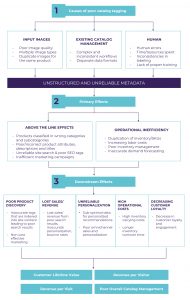Ecommerce Automation Platform For Fashion: Kill Excel Sheets Now!6 min read
Table of Contents
Excel sheets are popular, convenient and practical for millions of users worldwide. But, are spreadsheets enough to derive insights out of your data? Does Excel enable your data analytics to drive your sales? Are your merchandising, buying, sales and marketing team talking to each other with data points to understand (and give) what your shoppers want? Ecommerce Automation Platform For Fashion is the solution to this problem.
In a study on the spreadsheets, nine experiments using over 1,000 participants in total have found an average error detection rate of 60%.
33% of large businesses report poor decision making due to spreadsheet problems.
The hypothesis that while spreadsheets are great for organizing data, they don’t necessarily show the ‘bigger picture’ with data that is shared, updated, consumed and churned for real-time action, is why you should ditch the Excel for your retail business.
You probably have large teams who spend countless hours compiling and updating user-generated content. Somewhere in your company, there is a folder filled with numerous sheets that, taken together, have your entire product catalog information. Elsewhere, there is another folder containing unclassified images that have been left on the back burner for the next available person to sort through and tag. If you are a tech-savvy business, you might have a part of your catalog that is completely digitized but chances are that you still need a small army to sort through, cleanse, and standardize them.
These unclassified products will never find their way to the store’s front end, rendering them undiscoverable. Even the ones that do make it would have gone through hours and hours of manual attribution, and might still have sub-par product metadata.
Your shoppers are dropping off since they are unable to locate their favorite items, your bounce rates are sky high, your search results are inaccurate and your products are not SEO optimized – leaving you with significant untapped revenue and a shaky foundation for your catalog management process.
This can get messy, quickly.
If you are a multi-channel seller, product information management requires information changes and updates in multiple places and channels. Your product data has to be formatted with extra information in order to make it customer-ready.
“Automation can save retailers up to 90% in operation and human costs.”
A growing retailer today is constantly expanding the breadth of their catalog and is finding ways to push SKUs across different channels. With this comes the deeper nuances of catalog management, working with multiple suppliers and their varied product information structures, finding ways to standardize and update product information in real time, ensuring that all stakeholders have a single view of the catalog for real-time decision making and ensuring that the right products reach the right set of customers at the right time.
What Is Stopping Retailers Today From Having A Single Centralized View Of Their Catalog?
Today, teams spend hours daily, manually sorting through catalog images, classifying them, adding product attribute information and making them eCommerce ready. Associated with this are problems of spelling errors, time constraints, disparate image formats, duplicate product images and various other inconsistencies in the data that teams need to tackle first. In addition to this, there is no established manual method to connect real-time shopping behavior with catalog information which means that it becomes impossible to track product movement across channels, or a customer’s interaction with any given product.
The lack of an automated catalog management system increases the risk of a retailer relying on product data that is prone to inconsistencies. According to Experian, poor product data quality costs businesses over $3.1 trillion in the US alone, which is roughly around 20% of their revenues!
What Is Metadata And Why Is It Important To Standardize It?
“Metadata” – is all product attribute information that includes titles, descriptions, stock, price, brand, category and other relevant words or phrases. It is the only identifiable set of information for any given product, which is used by different teams across a company for internal and customer-facing products.
So, where is metadata needed:
Catalog Management:
- Product information (titles and descriptions, categories, attributes)
- Tracking the life cycle of a product across channels
- Inventory management (procurement, stock data collection)
- Understanding trends and customer behavior
End-customer Touch-points:
- On-site search and attribute filters
- External search engines and SEO
- Personalization engine and recommendations engines that use product attributes
What Causes Unreliable Metadata And How Does It Affect Operational Efficiency?
Teams across departments rely on the quality of the product metadata to make decisions around inventory, forecasting, and supply. An incomplete view of the entire catalog gives way multiple views of the product and customer, leading to misallocation of resources, inaccurate inventory forecasting and an increase in operational costs.
Discrepancies In Information From Different Sellers
Data has to be exported to and imported from various sources from a wide range of sellers who have different formats, vocabularies, and methods of documenting product information.
Quality Of Product Images
Input product images vary from photo-shopped garment images to professionally shot model images, to user-generated content. The lack of standardization leads to difficulties in adding appropriate product information.
Manual Hours Spent
The process of manually identifying metadata tags is prone to human errors like spelling mistakes, incorrect category mapping, duplication of information and ambiguous product titles.
Outdated Existing Product Information Management Systems
That require significant “hacks” to make them compatible with newer e-commerce systems.

How Does Poor Metadata Impact Customer Experience?
When a poorly tagged catalog exists, the discover-ability of the catalog is heavily impacted. Product tags are fed into indexing the site content and with inherent inaccuracies, on-site and external search engines pick up product related words that are not relevant to what the shoppers are looking for.
Customers are faced with zero search result pages – the top reason for high website bounce rates. At a more nuanced level, metadata is used by data and AI engines that personalize shopper journeys with products that are tailored towards certain attributes or facets that they are interested in. When the input metadata is incomplete, a retailer’s understanding of the end customer also becomes incomplete.
What metrics are impacted by an unreliable product information system?
- Revenue per Visitor
- Revenue per Visit
- Customer Lifetime Value
- Website Bounce Rates
Managing a catalog like classifying products into categories, identifying attributes and creating titles and descriptions, can be a tedious process if done manually, requiring substantial resources and time and causes human fatigue. Manual processes and issues associated with them and different input images of different format and type, contribute to inconsistencies in the metadata. Poorly classified products cause the quality of the data to suffer, leaving retailers with product information that is not standardized across all distribution channels.
This prevents teams across an organization from having one single view of their catalog and customers. Poor data quality results in:
- Operational inefficiencies: the increase in labor costs, inaccurate demand forecasting and merchandising
- Inaccurate site search results and product discovery
- Non-robust SEO tags
- Lost sales and revenue due to site abandonment
- Shopper frustration due to navigational issues
Here’s What You Need!
VueTag is the answer to Ecommerce Automation Platform For Fashion. VueTag uses Image Recognition to instantly help you digitize your catalog 10x faster than before with accurate product attribute tags like color, pattern, sleeve-length, style, neckline and more. Add to this, an automatically generated title and description for each one and you have taken your products from offline to online, faster than you’ve ever done before. The best news – no manual intervention, unless of course, you wish to review and edit and let the tool take the feedback and fix itself.
Upload, review tags, publish and you’re done! Go online to offline in 3 easy steps.
Learn more about personalized search



